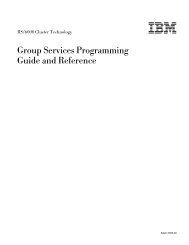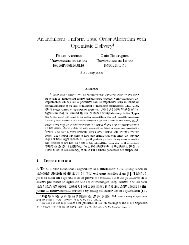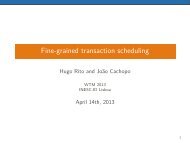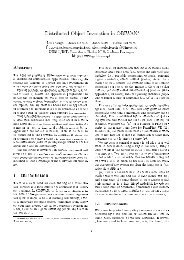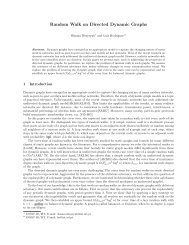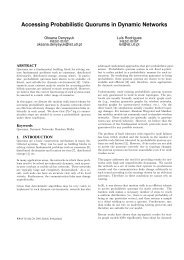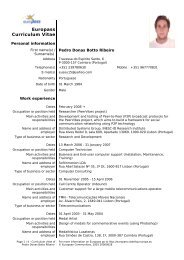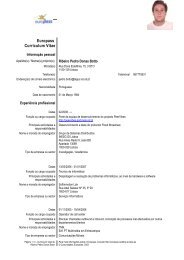Selfish and Malicious Behavior in Delay-Tolerant Networks
Selfish and Malicious Behavior in Delay-Tolerant Networks
Selfish and Malicious Behavior in Delay-Tolerant Networks
You also want an ePaper? Increase the reach of your titles
YUMPU automatically turns print PDFs into web optimized ePapers that Google loves.
Figure 5 Average Latency as function of the percentage of Types I <strong>and</strong> II misbehav<strong>in</strong>g nodes<br />
5.5 – Average Message Overhead Ratio<br />
Figure 6 shows that Epidemic <strong>and</strong> Prophet have the highest values of overhead ratio. This<br />
happens because of the similarities between these DTN rout<strong>in</strong>g protocols. Prophet only has<br />
smaller overhead because it uses a probabilistic metric that decides if it is worth replicat<strong>in</strong>g<br />
a message to a contacted node.<br />
Due to the similarities between DD <strong>and</strong> both versions of Spray <strong>and</strong> Wait, DD has zero<br />
overhead <strong>and</strong> Spray <strong>and</strong> Wait has smaller values of overhead ratio <strong>in</strong> comparison with other<br />
DTN rout<strong>in</strong>g protocols.<br />
Figure 6 Average Overhead Ratio as function of the percentage of Types I <strong>and</strong> II misbehav<strong>in</strong>g nodes<br />
6. Discussion <strong>and</strong> Conclusion<br />
We studied the impact of two types of node misbehavior on seven DTN rout<strong>in</strong>g protocols.<br />
The simulations show that <strong>in</strong> the presence of misbehav<strong>in</strong>g nodes, Epidemic <strong>and</strong> Prophet are<br />
quite robust as they have no limits to message replication <strong>and</strong> may even benefit from<br />
misbehav<strong>in</strong>g nodes as they may reduce network congestion. Maxprop <strong>and</strong> Rapid, for<br />
scenarios without misbehav<strong>in</strong>g nodes, have the highest values of delivery probability. But if<br />
we consider scenarios with misbehav<strong>in</strong>g nodes, the protocols are strongly affected by these<br />
types of nodes. Both versions of Spray <strong>and</strong> Wait have low values of delivery probability<br />
because of the scenario used. For cases of source <strong>and</strong> dest<strong>in</strong>ation nodes located <strong>in</strong> different<br />
clusters, unless the message was sprayed to a tram <strong>and</strong> then to a node <strong>in</strong>side the<br />
dest<strong>in</strong>ations’ node cluster, the message will never reach the dest<strong>in</strong>ation, so the delivery



